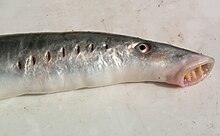Jawless fish
| Agnathans Fossil range: 535–0 Ma |
||||||||
|---|---|---|---|---|---|---|---|---|
 |
||||||||
| Scientific classification | ||||||||
|
||||||||
| Included groups | ||||||||
| Excluded groups | ||||||||
Agnatha (Greek, "no jaws") is a superclass of jawless fish in the phylum Chordata, subphylum Vertebrata, consisting of both present (cyclostomes) and extinct (conodonts and ostracoderms) species. The group excludes all vertebrates with jaws, known as gnathostomes.
The agnathans as a whole are paraphyletic, because most extinct agnathans belong to the stem group of gnathostomes. Recent molecular data, both from rRNA and from mtDNA as well as embryological data strongly supports the hypothesis that living agnathans, the cyclostomes, are monophyletic.
The oldest fossil agnathans appeared in the Cambrian, and two groups still survive today: the lampreys and the hagfish, comprising about 120 species in total. Hagfish are considered members of the subphylum Vertebrata, because they secondarily lost vertebrae; before this event was inferred from molecular and developmental data, the group Craniata was created by Linnaeus (and is still sometimes used as a strictly morphological descriptor) to reference hagfish plus vertebrates. In addition to the absence of jaws, modern agnathans are characterised by absence of paired fins; the presence of a both in larvae and adults; and seven or more paired gill pouches. Lampreys have a light sensitive pineal eye (homologous to the pineal gland in mammals). All living and most extinct Agnatha do not have an identifiable stomach or any appendages. Fertilization and development are both external. There is no parental care in the Agnatha class. The Agnatha are ectothermic or cold blooded, with a cartilaginous skeleton, and the heart contains 2 chambers.
...
Wikipedia
